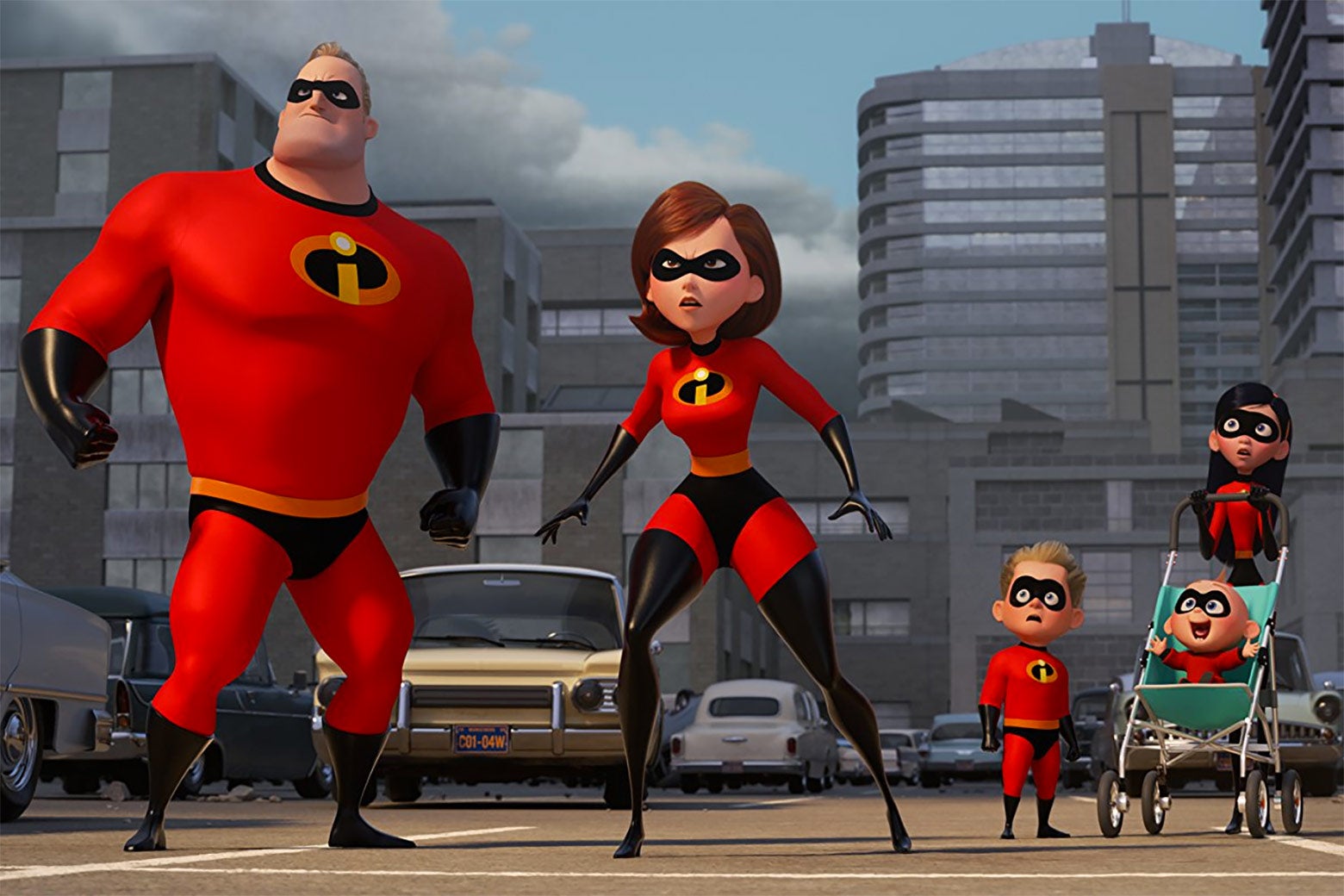In 2004, Brad Bird and Pixar Animation birthed The Incredibles into a world that, if not precisely starved for superheroes, was far more sparsely populated with them than ours is now. There were no Avengers, no Dark Knight, only a single, solitary Spider-Man, barely enough costumed crime fighters to fill a Quinjet, let alone stop Thanos from snapping half the universe away. The movie’s erstwhile heroes, Mr. Incredible (voiced by Craig T. Nelson) and Elastigirl (Holly Hunter), were reduced to being plain old Bob and Helen Parr, their outlawed extraordinariness reined in by a society in which “supers” were more envied than admired, more feared than loved. They were four-color characters forced to live a black-and-white life.
Although nearly a decade and a half has passed since the original film’s release, Incredibles 2 picks up right where the first left off: Violet (Sarah Vowell) is still an awkward teen with the power to make herself invisible (although not, sadly, to make the boy she has a crush on really see her); her younger brother Dash (Huck Milner) is hyperactive and superfast; and infant Jack-Jack is just coming into his powers, which are more unpredictable and more various than his harried parents can keep up with. Superheroes are still illegal, and the movie’s opening sequence reminds us why: In attempting to foil a bank robbery by the Underminer (Pixar standby John Ratzenberger), Bob inadvertently reroutes the villain’s giant drill through downtown Municiberg, where it trashes buildings, rips up streets, and very nearly levels City Hall. As Bob is dressed down by government agents for the mess he’s made, he sputters, “Am I just supposed to do nothing?” and it turns out the answer is yes. The bank’s money is insured, and letting one bad guy get away with his crime isn’t so bad compared with the collateral damage of a battle royal.
In Incredibles 2, superheroes aren’t just illegal; they’re irrelevant. Not every wrong can be righted without them, but the world has other ways of coping. Bird’s previous Pixar movies, The Incredibles and Ratatouille, were built on a determinist philosophy in which there were people who were special and those who were not, and the latter’s job was simply to get out of the former’s way and let them lead. But perhaps rankling from the frequent accusations that those ideas put him in league with Ayn Rand, Incredibles 2 seems to suggest that perhaps the supers aren’t so super after all. While tech mogul and superfan Winston Deavor (Bob Odenkirk) and his sister, Evelyn (Catherine Keener), urge Elastigirl out of retirement in a bid to rehabilitate costumed heroes’ collective image, Bob Parr stays at home and plays bumbling househusband, fumbling Violet’s adolescent emotional crises, furrowing his brow at Dash’s math homework, and frowning at Jack-Jack’s superpoopy diapers. Much of Bird’s work as a director is steeped in nostalgia for the naïve futurism of the 1950s and ’60s, but he doesn’t have to import the era’s gender politics along with it.
While Elastigirl is working to turn the public tide in superheroes’ favor, a masked villain called the Screenslaver is giving her something to fight against. Folding early-postwar paranoia about how television was rotting people’s brains into contemporary concerns about screen time, the begoggled baddie issues a manifesto about how superheroes condition people to prefer the virtual to the real: They’d rather watch talk shows than talk to one another. Like The Incredibles’ Syndrome, essentially a spurned fanboy with a lethal will to power, the Screenslaver is a half-smart antagonist whose rhetoric is just solid enough to make a satisfying noise as the movie’s heroes knock it down. Bird wants to be a filmmaker of ideas, but his movies are at their best when they’re pure action, whether it’s Tom Cruise scaling the Burj Khalifa in Mission: Impossible–Ghost Protocol or Elastigirl chasing a runaway maglev train on her motorcycle. The action sequences in Incredibles 2, which was edited by Stephen Schaffer, are elegantly conceived and fluidly executed, as good as anything we’re likely to see on screen this year, in animation or live action, which only makes the rest of the movie seem that much clunkier by comparison.
The first Incredibles was startling at the time for its nearly photorealistic backdrops, and that’s even more true of the sequel. There are shots of vegetation and night skies you could drop into a live-action movie and no one would be the wiser. But the movie’s flesh-and-blood characters are ill-served by the past decade plus’s advances in computer animation technology. The blobby figures of 2004 have acquired more detailed textures and sharper edges, but they’re now firmly encamped in the uncanny valley; I found myself puzzling over the circular creases in Elastigirl’s forehead rather than listening to the scene, more absorbed in the movie’s mechanics than its plot. That’s not just the case on a technical level: Incredibles 2 is a movie that lavishes attention on the details but loses sight of the whole, where you can’t see the forest for the meticulously rendered trees. What sticks in the mind isn’t its half-hearted conflicts but the design of the Parrs’ loaner mansion, which looks like James Mason’s hideout from North by Northwest, or the way the roof of a massive hydrofoil opens up to disgorge a hidden jet plane. Perhaps that’s like coming out of a four-star meal and raving about the tablecloths, but the world needs nice tablecloths, too.
